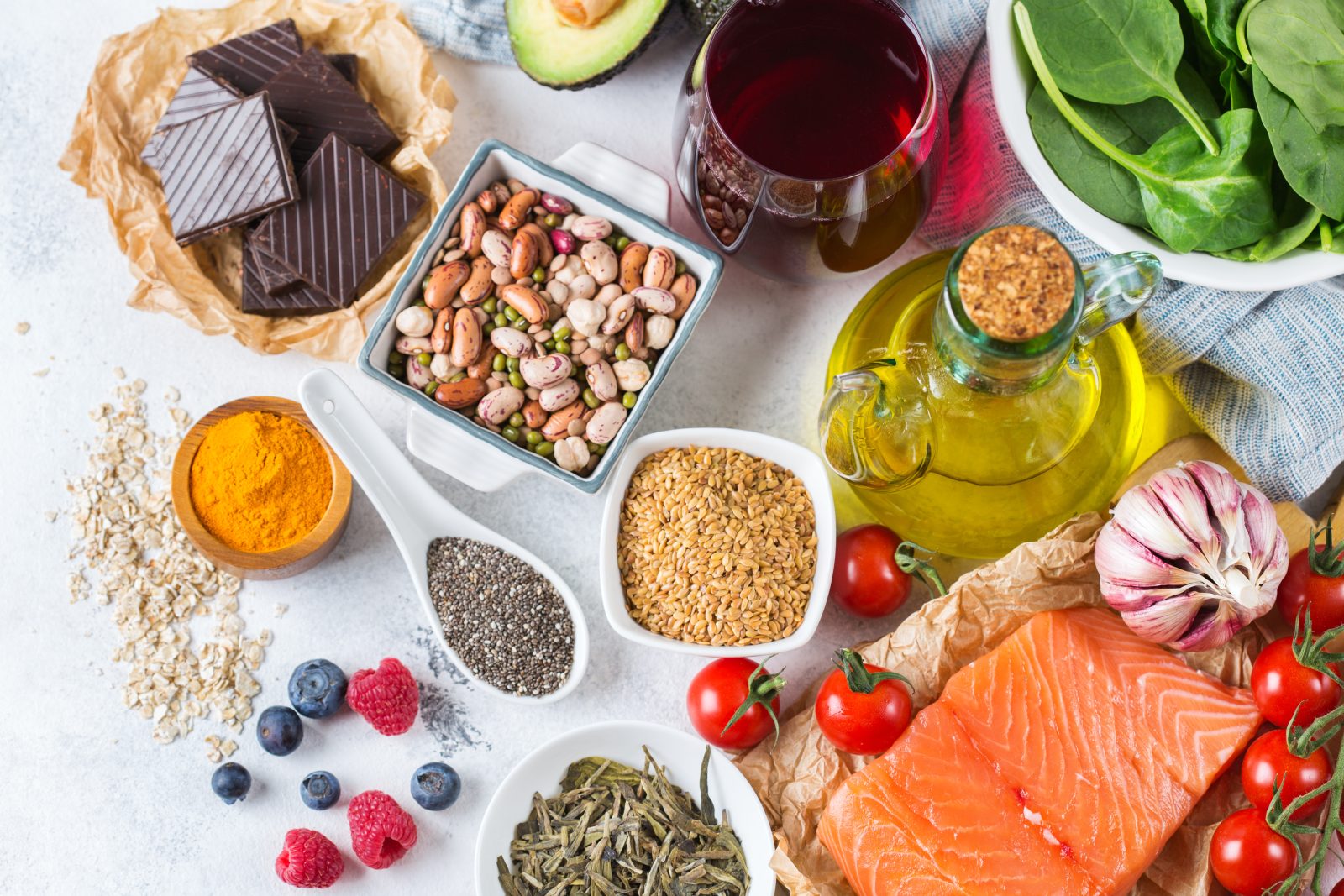Losing weight is often a challenging journey, but the inclusion of superfoods can make it more manageable and enjoyable. These nutrient-dense foods are not only delicious but also aid in boosting your metabolism, curbing your appetite, and providing your body with the necessary energy to power through your workouts.
The term “superfoods” is commonly used to describe foods extremely high in beneficial nutrients.
Several superfoods’ phytochemicals, antioxidants, and micronutrients may aid in weight loss.
Here are 20 scientifically proven superfoods that are especially helpful for slimming down.
What are superfoods?
Superfoods are natural foods that are exceptionally rich in nutrients, vitamins, minerals, and antioxidants. They offer an array of health benefits that go beyond basic nutrition. Incorporating superfoods into your diet can contribute to improved overall health, increased vitality, and, of course, effective weight loss.
The role of superfoods in weight loss
Superfoods play a pivotal role in your weight-loss journey. They are typically low in calories but high in nutrients, making them perfect for creating a calorie deficit without sacrificing essential vitamins and minerals. Additionally, many superfoods contain dietary fiber, which promotes feelings of fullness and reduces overeating.
1. Quinoa
The consumption of quinoa, a whole-grain superfood, has increased in recent years.
Manganese, magnesium, folate, and phosphorus are all abundant in quinoa, and the grain is also high in protein.
Not only that, but it’s one of the few plant-based sources of complete protein, meaning it has all nine of the most important amino acids. It may help curb hunger due to the high protein content.
Quinoa can be used in place of rice, couscous, or barley in any recipe calling for that grain. Add grain salads, soups, stews, and veggie burgers for a delicious and nutritious twist.
2. Yogurt
Calcium, vitamin B12, phosphorus, and riboflavin are all abundant in yogurt, and it’s also a good source of protein.
Greek yogurt, in particular, is packed with protein and may aid in weight loss.
Probiotics are present in some varieties as well, and they may play a role in weight management and satiety modulation.
Yogurt consumption has been associated with a lower body weight and a lower risk of developing metabolic disease and type 2 diabetes in multiple studies.
Yogurt is a healthy, high-protein addition to many recipes; try topping it with fresh fruit, nuts, and seeds or incorporating it into dips and spreads.
3. Grapefruit
The flavor of grapefruit ranges from sour to sweet to bitter, making it one of the most well-known citrus fruits.
Grapefruit is an excellent daily source of fiber, and vitamins A and C.
It has a low calorie count, and, according to a few historical human and animal studies it may aid in weight loss and fat burning.
The combination of salt and sugar in grapefruit is a common way to eat and enjoy this citrus fruit. Salads, salsa, smoothies, and juices all benefit from the addition of grapefruit.
4. Green tea
Diseases can be fought off with the help of polyphenols and antioxidants found in green tea.
Antioxidants such as quercetin, chlorogenic acid, and theogallin are particularly abundant in green tea.
It also contains a high concentration of the antioxidant epigallocatechin gallate (EGCG), which, when taken in large amounts, has been shown to promote weight loss, raise metabolic rate, and decrease abdominal adiposity.
Green tea can be enjoyed on its own or with the addition of lemon, honey, or ginger.
5. Salmon
The nutritional value of fatty seafood like salmon is very high.
In addition to heart-healthy omega-3 fatty acids, B vitamins, selenium, and potassium can also be found in abundance in salmon.
It’s one of the greatest protein sources, so it might help you control your hunger and feel full for longer.
Salmon is a versatile fish that may be prepared in many ways (baking, searing, grilling, or pan-frying) and served with a variety of healthful side dishes and grains.
6. Oats
Whole-grain oats are a fan favorite at breakfast time. Avena sativa is their official scientific name.
Fiber, manganese, phosphorus, copper, and protein can all be found in them.
Several studies have found that oats’ high protein and fiber content can help with weight management and satiety.
Oats can be enjoyed in a variety of forms outside of oatmeal, such as yogurt, smoothies, porridge, and baked products.
7. Tomatoes
Tomatoes, with their acidity and flavor, are a great complement to any healthy weight-loss diet.
Tomatoes are an excellent source of many nutrients, including vitamin C, vitamin K, and potassium, as well as antioxidants.
Tomatoes may aid in long-term weight loss because of their low-calorie density and high water content.
Tomatoes are a versatile ingredient that can spice up any salad, wrap, or sandwich. They are also great for making jams, sauces, and other condiments.
8. Walnuts
Tree nuts, like walnuts, are prized for their high nutritional density.
Walnuts are an excellent source of omega-3 fatty acids, as well as vitamin E, folate, and copper.
Studies reveal that the body absorbs 21% fewer calories from walnuts than would be predicted based on its nutritional value, despite the fact that walnuts are quite heavy in calories.
Walnuts have been demonstrated to suppress appetite and curb hunger, which could aid in weight loss over time.
Salads, cereals, oats, and yogurt all benefit from the addition of heart-healthy walnuts. They make a satisfying snack when seasoned and toasted.
9. Apples
Apples are not only extremely tasty but also highly beneficial to your health.
Apples are a great source of micronutrients like vitamin C and potassium, as well as antioxidants.
In addition, they provide the soluble fiber pectin, which, according to some research done on animals, can help people eat less and lose weight.
Multiple studies have found that adding apples to a balanced diet can help you lose weight and enhance your health in general (31, 32, 33).
Whole, raw apples are a great source of fiber and other nutrients. You can also have them sliced and dipped in a creamy spread like cream cheese or tangy yogurt.
10. Spinach
Originally from ancient Persia, spinach has become a popular leafy green vegetable around the world.
It’s a great source of dietary fiber, vitamins C and A, and iron, and it’s low in calories.
Additionally, spinach thylakoids may slow fat digestion and lessen appetite.
Spinach may be incorporated into your diet in many novel ways, in addition to salads. It can be used to add color and micronutrients to foods like stir-fries, soups, smoothies, and pasta.
11. Chickpeas
Chickpeas, or garbanzo beans, are a type of legume that is genetically linked to other beans such as kidney beans, black beans, and pinto beans.
Chickpeas are an excellent source of minerals manganese, folate, phosphorus, and copper.
Additionally, the high fiber and protein content of chickpeas has been shown to aid in weight loss.
To make a dish vegetarian, simply replace the meat or fish with chickpeas. For a quick snack, try baking or roasting some chickpeas and seasoning them with some of your favorite herbs and spices.
12. Bell pepper
Bell peppers, also known as sweet peppers, are an incredibly healthy vegetable that comes in a rainbow of colors.
They are an excellent source of fiber and a number of other beneficial elements, such as vitamin C, B6, and potassium.
Their high water content means they are naturally low in calories, making them a useful weight-reduction food replacement.
Snack on bell peppers and a low-calorie dip like hummus, tzatziki, or yogurt. You can also dice them up and use them as an accent in dishes like soups, salads, and stir-fries.
13. Kimchi and sauerkraut
In traditional Korean cooking, kimchi is a staple. Pickled vegetables like cabbage and radish are common ingredients.
This dish has a European counterpart called sauerkraut, which likewise uses fermented cabbage in its preparation.
Kimchi and sauerkraut are two of the best examples of fermented foods that are rich in probiotics. In addition to being located in your gut, these beneficial bacteria are associated with numerous health benefits.
Some research indicates that probiotic supplementation may influence appetite and satiety, potentially influencing weight regulation.
Eat kimchi with rice or incorporate it into your stews, grain bowls, or noodle dishes to increase your intake of beneficial bacteria. Sauerkraut pairs well with a wide variety of sausages, both meat- and plant-based. The flavor complements the cheese nicely.
Unlike with certain other condiments, there are no hard and fast rules about what you should eat with kimchi or sauerkraut. Many individuals also consume them independently.
Choose kimchi and sauerkraut without additional preservatives or sugar, and stay away from pasteurized options. You can find it in the grocery store’s cold storage.
Homemade kimchi and sauerkraut are similarly simple to prepare.
14. Sweet potatoes
It’s common knowledge that sweet potatoes are an excellent source of vitamins and minerals.
Antioxidants, vitamins A and C, manganese, and B vitamins are all abundant in them.
In addition, the high fiber content of sweet potatoes aids in satiety for longer, which is associated with reduced calorie intake and fat storage
Sweet potatoes are versatile and can be prepared in many ways: as a snack, a side dish, mashed, boiled, or sautéed.
15. Avocado
The nutritional value and distinctive flavor of avocados have made them a popular food item.
In particular, avocados are rich in several nutrients, including potassium, folate, and vitamins C and K.
Although avocados are high in calories, the fiber and heart-healthy unsaturated fats they contain can help you feel full between meals, making it easier to cut back on food intake and thus aiding in weight loss.
Toast, salads, soups, and even scrambled eggs can all benefit from the addition of avocados due to their creamy texture and robust taste. Guacamole, hummus, and salsa are just a few examples of sauces and dips that benefit greatly from their inclusion.
16. Egg
Eggs are versatile, delicious, and simple to prepare. You can easily see why they are regarded as a top superfood for weight loss.
Selenium, vitamin B12, riboflavin, and phosphorus are just a few of the many vitamins and minerals that can be found in abundance in a single egg.
Eggs are a great source of protein, which has been shown to increase satiety and hence aid in weight loss.
Sprinkled with salt and pepper or a dash of spicy sauce, hard-boiled eggs make a delicious snack. Omelets, quiches, breakfast burritos, and stir-fries are just a few more ways to eat eggs.
17. Chia seeds
Among the many beneficial nutrients found in chia seeds are omega-3 fatty acids, calcium, magnesium, and manganese.
They are also rich in soluble fiber, which when combined with water, gels in the digestive tract.
Soluble fiber intake has been associated with lower body fat and more weight loss, according to two meta-analysis.
In addition to their fiber and healthy fat content, chia seeds are also a good source of protein.
Adding chia seeds to your favorite smoothies, yogurts, or oat bowls can greatly improve the taste and texture.
18. Berries
Strawberries, blueberries, and blackberries, among others, are full of life, flavor, and health benefits.
As an added bonus, they are a healthier alternative to many other high-sugar snacks and desserts.
The most common applications for berries are to make smoothies and top yogurt and cereal. They are also a great addition to a fruit salad, or can be eaten alone.
19. Broccoli
Broccoli is a nutritious powerhouse that can help you shed excess pounds in a healthy way.
Particularly rich in fiber and minerals including vitamin C, folate, potassium, and manganese, broccoli is a healthy addition to any diet.
Broccoli, like other cruciferous vegetables, has been shown in multiple studies to aid with weight management.
For a simple and fast side dish, try seasoning your broccoli with garlic, lemon juice, or Parmesan cheese. Broccoli is a great way to increase the nutritional value of foods like salads, casseroles, quiches, and pasta.
20. Kale
The lush green vegetable kale has gained popularity due to the widespread belief that it improves health.
It’s rich in antioxidants and has a number of important elements like manganese, vitamin C, and vitamin K.
Additionally, kale is high in fiber, which makes you feel fuller for longer, and passes slowly through your digestive system, both of which may aid in weight loss.
Add kale to your favorite salad, sauté it with garlic for a quick side dish, or toss it in pasta for a colorful new twist.
Incorporating these 20 superfoods into your diet can have a transformative impact on your weight-loss journey. Remember that no single food can guarantee instant results, but a balanced diet rich in superfoods can certainly accelerate your progress. So, embark on this delicious and nutritious journey to a healthier you!
















Find Us on Socials